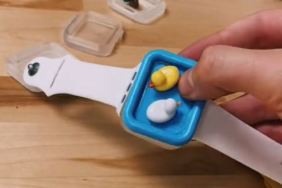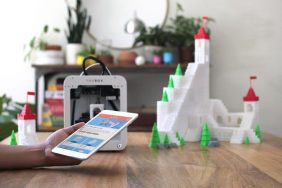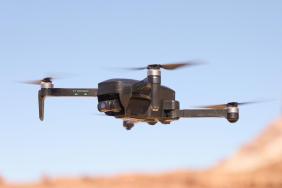As I sit here on my 3D printed chair, using my wearable data glasses to compose this article by voice recognition on a 3D television while my virtual reality helmet takes me on a tour of 19th century Belize, I wonder why none of this nonsense is actually happening because a lot of the hype that comes out of any given year’s Consumer Electronics Show often turns out to be absolute bollocks.
We’ll know in a couple weeks what the major buzz will be at CES 2016, but many would-be trends of the last few years were the talk of Las Vegas during the world’s largest tech convention turned out to be either false fuss or advancements that needed significantly more time to advance.
Also: CES 2016: Acton Pointing the Way for Personal Mobility
So, here we present just a handful of the greatest, world changing CES trends that never were — or weren’t yet, at least.

3D Television: This idea seemed so big and such a consumer market slam dunk that there were separate 3D consumer shows beyond CES. The major TV manufacturers each had their special units ready, and smaller startup companies were looking to enhance the big boys’ tech. There would be 3D screens on everything from giant TVs to tiny cellphones.
No, there wouldn’t. Just as 3D plays out in movie theaters, the technology for home use is still looked on as more of a novelty than a must have. Part of the problem is the technologies only work when the viewer is right in front of the screen or in that vicinity. That doesn’t make for the best communal viewing experience — which is part of television overall success. And, there are those damn silly glasses. Somehow, putting those dorky things on your mug seems like too much work for a device designed to offer passive enjoyment.
If engineers ever perfect glass-free 3D viewing, it might emerge into wide use. For now, no one longs to look like a multi-colored Roy Orbison to watch TV. And, off that dated reference, we move to…
Smart TVs: Sticking with the idiot box here, recent CES runs saw a passing flirtation with televisions armed with everything from interactive screens to video chat cameras to onboard apps to inbuilt game systems. It was looked on as another step into the world of the TV as all purpose household console — incorporating television, computer function, communications and missile launcher (apparently).
We’ve been hearing about the inevitability of this all purpose device’s evolution since the 1990s. Has any0one noticed it’s not happening? Evidently not. The experts continue to miss the reality that we still have both computers and televisions well into the 21st century because (again) consumers see TVs as passive technology. Turn on. Watch. Forget. When they want to do something more active and purposeful, they break out the laptop (probably wasting time with equally passive online tripe — but that’s another gripe for another story).
Strangely enough, we are seeing a marriage of computer and television via smartphones and tablets. However, a TV is still a TV because people like it that way.

4K or Ultra HD: I promise we’ll get off TVs after this one. This next stage in the development of HDTV might be taking it too far as our eyes can’t seem to keep up real well. Some say 4K looks better than reality. Considering how ugly many aspects of reality are, whoopee. It’s becoming clear HD was enough for most consumers. They don’t need to see every Botox injection scar on Bill Maher’s face thanks to 4K.
Of course, 4K or Ultra HD might find its way into the mainstream by default as standard HD might simply give way to it across the board. If so, 4K wins by default — but no one is begging for its victory.
3D Printing: This one will still be big at CES 2016. It’ll be impossible to wiggle your way through the asses to elbows crowd in the middle of the convention hall as the 3D printer companies crank out little personalized dollars and other essentially useless test trinkets. But we’re not seeing it transitioning to consumer popularity outside of the convention.
By now, we were all going to have 3D printers in our homes. We’re supposed to printing our own shoes, plates, food, auto parts, etc. We’d never leave the front door. The only stores that might survive would sell blocks of resin, and those would fold once Amazon sold only the same globs of plastic.
Of course, everyone was so busy getting their nerdier natures aroused by the wonders of sci-fi molding, few took the time to analyze the realities of marketing 3D printing. First, it’s expensive. The printers aren’t cheap, and people go through the materials quickly if they print in any bulk. Also, it’s time consuming. And, who thought we wanted everything in our lives made from the same types of plastics, ingredients, etc.? Finally, if you print that auto part (or anything else from the manufactured world), you just violated a patent. That’s a federal crime.
In truth, 3D printing is more of an industrial tool now with companies figuring out what they can make from the process. We’re still years away from consumers taking it into their homes.

Wearables: I’m looking at you, Google Glass – but I’m not looking through you because the Singularity-happy idea of the human cyborg married to body-fused technology is taking longer than expected. Why? Because the whole idea is damned creepy, and it’s hard to market creepy. Most would-be buyers don’t want to wear anything that tracks their every movement, records their friends at will and constantly pumps information to them. They’ve got that 24/7 buzz in their lives already with their smartphones.
Obviously, Apple Watch and its ilk are bucking this trend. But, I maintain that the smart watches are largely fitness trackers. Some are more advanced than others, but their main function is to shame a fat backside into getting moving.
When you look over this collection of near misses, one fact remains true. None of these once and future tech trends went away. They’re still out there cooking. The odds are they each will find their way into the consumer electronics mainstream, given a little time.






